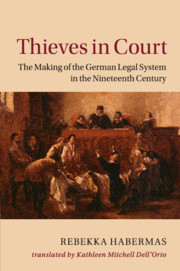Book contents
- Frontmatter
- Dedication
- Contents
- Acknowledgments
- Introduction: Questions Regarding Thieves, Reformers, Jurists, and Others
- PART I WHAT IS THEFT: QUESTIONS REGARDING THIEVES AND JURISTS – QUESTIONS REGARDING HONOR AND PROPERTY
- PART II HOW LAW IS MADE: EVIDENCE PRODUCTION
- PART III IN THE COURTROOM, OR WHAT IS LAW?
- 7 Reforms for More Legal Equality, Justice, and Public Openness?
- 8 The Meaninglessness of Jury Courts for Justice
- 9 Legitimation through Procedure
- 10 Irritations, Dissonances, and Various Other Matters: More Than Just Theater
- Conclusion: The Making of the Modern Legal System – Thieves and Property
- Relevant Laws
- Bibliography
- Index
8 - The Meaninglessness of Jury Courts for Justice
from PART III - IN THE COURTROOM, OR WHAT IS LAW?
Published online by Cambridge University Press: 18 November 2016
- Frontmatter
- Dedication
- Contents
- Acknowledgments
- Introduction: Questions Regarding Thieves, Reformers, Jurists, and Others
- PART I WHAT IS THEFT: QUESTIONS REGARDING THIEVES AND JURISTS – QUESTIONS REGARDING HONOR AND PROPERTY
- PART II HOW LAW IS MADE: EVIDENCE PRODUCTION
- PART III IN THE COURTROOM, OR WHAT IS LAW?
- 7 Reforms for More Legal Equality, Justice, and Public Openness?
- 8 The Meaninglessness of Jury Courts for Justice
- 9 Legitimation through Procedure
- 10 Irritations, Dissonances, and Various Other Matters: More Than Just Theater
- Conclusion: The Making of the Modern Legal System – Thieves and Property
- Relevant Laws
- Bibliography
- Index
Summary
IN WHICH COURT?
Let's begin the close-up view of the trial at the point where the decision was made as to the place, more specifically, the court in which the trial was actually supposed to take place. Since 1848, there had basically been two options: the newly instituted jury court, or a court in which only the state procurator and one or two judges, sometimes with the addition of an attorney, had final say. But how was the important decision made about the court in which a case was to be tried?
For this question – as was already indicated in connection with court density – the kind of crime and the anticipated severity of the penalty were decisive. Which cases were brought before a Schwurgericht and which were adjudicated without jurors? Since 1851, Schwurgerichte had generally had jurisdiction for high treason, offenses against the sovereign, certain “press offenses,” and cases that were punishable with at least a five-year sentence of detention, forced labor, or prison, or a sentence of at least four years in irons. What did that mean in concrete terms for handling property crimes? The answer leaves nothing to be desired in the way of clarity; the overwhelming majority of thefts, that is, the so-called simple thefts, did not end up in Schwurgerichte but instead in lower courts. Only a tiny number of thefts, so-called qualified and repeated thefts, were actually tried before a Schwurgericht. They were either thefts in which extremely valuable items had been stolen – which did not happen very often – or the accused had prior convictions. As a rule, the latter had to expect at least the high court, even for theft of almost worthless articles. For example, a case of the theft of a sheep in 1852 was brought before a Schwurgericht because the accused already had four prior convictions for theft. A similarly hard line was taken with Anton Zimmermann, whose bread theft was tried before a Schwurgericht for the simple reason that he already had six small thefts on the record books. In short, decisive for where a theft case was tried was the value of the article stolen, the kind of theft, and the number of prior convictions – without any of these criteria outweighing the others.
- Type
- Chapter
- Information
- Thieves in CourtThe Making of the German Legal System in the Nineteenth Century, pp. 199 - 208Publisher: Cambridge University PressPrint publication year: 2016



